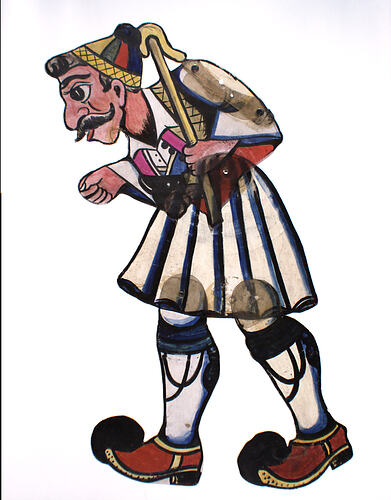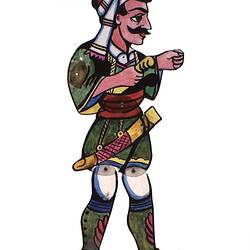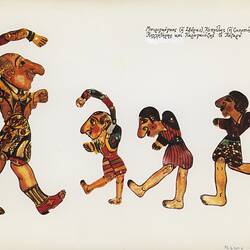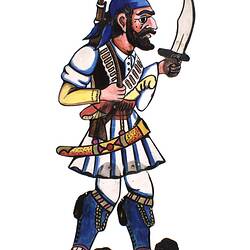Summary
Alternative Name(s): Uncle Yiorgos
This puppet was made in 1960 by the Greek puppeteer and popular artist Abraam (Antonakos) in his Athens workshop, and by Dimitri Katsoulis. This and most of the puppets in the collection were brought to Australia by Abraam Antonakas for his performances at the Astor Theatre in Melbourne in 1977. He then left the collection with Dimitri Katsoulis who used them in all his subsequent performances in Victoria and in South Australia from 1978 to 1991. It was drawn by Abraam, but as Dimitri often assisted with the performances, he did all the preparatory work (transfering the pieces of the puppet onto the acrylic, cutting and sanding the acrylic with sandpaper so that it becomes opaque in order that the colours can adhere better]. Dimitri Katsoulis migrated to Australia in 1974 to escape a regime that repressed Greek artists. He had trained in Greece with theatre and film companies as an actor and technician. A master of the traditional Greek shadow puppet theatre, his performances explored contemporary issues such as the isolation of migrant women and children. Unable to obtain funding and support, he returned to Greece in 1991, leaving his entire collection to the people of Victoria. It includes 32 shadow puppets and around 170 props, set backdrops and technical tools and stage equipment. Dimitri has since returned to Melbourne and assists the Museum to continue to document this rich art form within both local and international contexts.
Yiorgos Blajaras is a character in the centuries-old Greek Shadow Puppet Theatre (Karaghiozis) tradition. He is the perfect image of the innocent man from the mountains (the country). He is pure, ethical, honest, kindhearted, miserly, innocent, naïve, guileless, and a 'sweetheart.' He is well-built with enormous strength, and he is feared by the local executive authority. He is also a protector of the weak. Yiorgos Blajaras appears on the stage in comedies where he is always in love, and also in heroic dramas.Yiorgos Blajaras appears on the stage in the introduction before the main play, singing and dancing and at some point Thervenagas [another Greek Shadow Puppet Theatre character] always interrupts him on the Pasha's [a state ranking political advisor] orders. He always asks who has interrupted his song and why. Thervenagas tells him that he has and pushes him out of the way. Yiorgos Blajaras wants to know why and Thervenagas acts tough, like a big hero. Uncle Yiorgos makes fun of him, so he hits him. Uncle Yiorgos then gets angry, grabs him and beats him up. Thervenagas manages to escape and hides in Sarai. Uncle Yiorgos then withdraws. Yiorgos Blajaras is one of the principal puppets and all the puppeteers identify him by the same name.
The puppet is manipulated by a puppet rod [there are many examples in the collection] mounted at the top of its shoulder.
Information supplied by Greek Shadow Puppet Theatre master Dimitri Katsoulis, 2007.
Physical Description
A two-dimensional acrylic figure, jointed at the waist and knees, wearing traditional Greek dress. He wears a striped cap and multi-coloured waistcoat; white shirt with wide sleeves; white pleated tunic and red shoes decorated with large pom-poms. He carries a yellow stick over one shoulder.
Significance
This collection of puppets, props, stage sets, and technical tools and equipment relating to traditional Greek Shadow Puppet Theatre is unique in Australia and rare in international public collections. The history of Greek Shadow Puppet Theatre, its puppet characters and the methodology of its performance has been recorded in partnership with the puppet master to whom the collection belonged. The collection is highly significant both as documentation of an important cross-cultural, centuries-old art form, and as an example of the transnational migration of cultural activity between Greece and Australia. It is a collection which was created and performed in Greece and Australia from the mid to late twentieth century, by two puppet masters, who transported the tradition between two countries. Abraam Antonakos came to Australia in 1977 to perform the puppet theatre and then deposited the puppets with Dimitri Katsoulis, who had migrated to Australia in 1974. Dimitri's story becomes one of migration experience, cultural maintenance and adaptation, and finally return migration and the discontinuance of this cultural art form in Australia.
More Information
-
Collection Names
-
Collecting Areas
-
Acquisition Information
Purchase
-
Artist
-
User
Mr Abraam Antonakos, Athens, Greece, 1960-1977
Abraam made the puppet in Greece, and used it in performances during the 1960s and 1970s; and then in Victoria in 1977. -
User
Mr Abraam Antonakos, Victoria, Australia, 1977
Abraam made the puppet in Greece, and used it in performances during the 1960s and 1970s; and then in Victoria in 1977. -
User
Mr Dimitri Katsoulis, Australia, 1978-1991
Dimitri was given the puppet by Abraam in 1977 and then used it in his performances in Australia until 1991. -
Classification
-
Category
-
Discipline
-
Type of item
-
Overall Dimensions
34 cm (Length), 89 cm (Height)
-
Exhibition Collection Management
340 mm (Width), 890 mm (Height)
-
References
[Link 1] Malkin, Michael, R. Traditional and Folk Puppets of the World, A.S. Barnes & Co., Inc., N.J., 1977; Simmen, Rene, The World of Puppets, Elsevier, Phaidon, London, 1975; Hogarth, Ann & Bussell, Jan, Fanfare for Puppets!, David & Charles Publishers Ltd, USA, 1985; Yayannos, A & Ar and Dingli, J. The World of Karaghiozis, 1976
-
Keywords
Cultural Maintenance, Greek Communities, Greek Immigration, Karaghiozis Theatre, Shadow Puppetry, Theatres, Working Life



